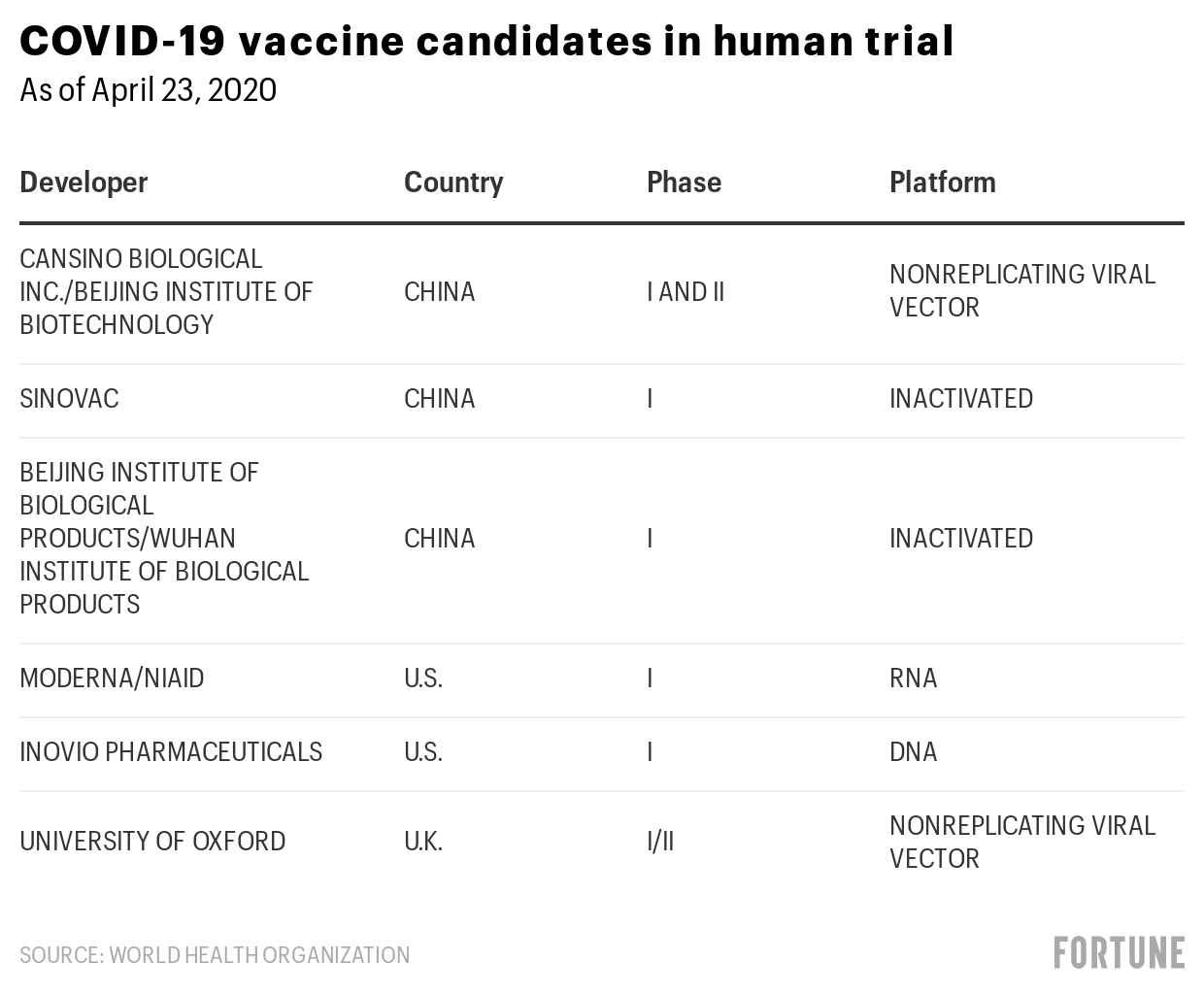世界衛生組織在上周四(4月23日)表示,又有三種新冠病毒疫苗進入了人體試驗階段,從而使處于該階段的疫苗總數達到6種。世衛組織上次公布疫苗數據是在4月14日。
目前全球新冠肺炎確診病例已超290萬人,死亡超20萬人,新冠疫情引發的大規模封城正在讓經濟走向災難,而全球醫療界正以前所未有的速度與合作措施來開發新冠疫苗。然而,盡管人們迅速采取行動來抗擊這種致命病原體,但專家們表示至少還要12到18個月才能開發出疫苗,而且即使這樣的預期也顯得較為樂觀。
這6種進度最快的疫苗均處于一期或二期臨床試驗階段,而臨床試驗的目的是評估疫苗對人體是否安全和有效。一期和二期臨床試驗之后還有三個階段,即三期臨床、監管審核以及四期臨床。

在這些最有希望的疫苗中,有三種在中國開發,而中國是首先出現新冠疫情的國家。
總部設在天津的康希諾生物和中國軍事醫學科學院生物工程研究所共同開發的疫苗已進入一期和二期臨床實驗階段。
康希諾生物的新冠疫苗基于該公司研制埃博拉病毒疫苗時開發的技術。總部設在北京的科興生物開發的新冠疫苗則以2004年應對非典疫情時的經驗為基礎,目前處于一期臨床階段。
中國軍事醫學科學院生物工程研究所與武漢生物制品研究所聯合開發了中國第三種處于領先位置的新冠疫苗,同樣處于一期臨床階段。
第四種有希望的疫苗由美國生物科技公司Moderna和美國國家過敏癥與傳染病研究所(NIAID)共同研制。該疫苗已于3月中旬率先開始人體試驗,比預期的要早,目前則處于一期臨床階段。Moderna和NIAID能快速開發出疫苗要歸功于它們此前對非典和中東呼吸綜合癥等其他冠狀病毒的研究。
設在賓夕法尼亞州的小型生物科技公司Inovio Pharmaceuticals于4月初開始首次人體試驗。該公司的部分資金由比爾及梅琳達·蓋茨基金會提供。此前為對付艾滋病病毒、人乳頭狀瘤病毒、寨卡病毒和乙肝病毒而開展的工作為該公司研制新冠疫苗奠定了基礎。
英國牛津大學開發出了第6種進入人體試驗階段的新冠疫苗,其基礎同樣是此前針對中東呼吸綜合癥等其他冠狀病毒而付出的努力。負責此項工作的莎拉·吉爾伯特教授將新冠疫苗的快速研制歸功于對“疾病X”的研究,這是一種未知病原體,吉爾伯特教授及其團隊認為它會突然出現并有可能引發流行疾病。
除了這6種已經開始人體試驗的新冠疫苗,世衛組織還列出了另外77種處于早期臨床前評估階段的疫苗,比上次該組織公布的數字多了7種。(財富中文網)
譯者:Charlie
世界衛生組織在上周四(4月23日)表示,又有三種新冠病毒疫苗進入了人體試驗階段,從而使處于該階段的疫苗總數達到6種。世衛組織上次公布疫苗數據是在4月14日。
目前全球新冠肺炎確診病例已超290萬人,死亡超20萬人,新冠疫情引發的大規模封城正在讓經濟走向災難,而全球醫療界正以前所未有的速度與合作措施來開發新冠疫苗。然而,盡管人們迅速采取行動來抗擊這種致命病原體,但專家們表示至少還要12到18個月才能開發出疫苗,而且即使這樣的預期也顯得較為樂觀。
這6種進度最快的疫苗均處于一期或二期臨床試驗階段,而臨床試驗的目的是評估疫苗對人體是否安全和有效。一期和二期臨床試驗之后還有三個階段,即三期臨床、監管審核以及四期臨床。
在這些最有希望的疫苗中,有三種在中國開發,而中國是首先出現新冠疫情的國家。
總部設在天津的康希諾生物和中國軍事醫學科學院生物工程研究所共同開發的疫苗已進入一期和二期臨床實驗階段。
康希諾生物的新冠疫苗基于該公司研制埃博拉病毒疫苗時開發的技術。總部設在北京的科興生物開發的新冠疫苗則以2004年應對非典疫情時的經驗為基礎,目前處于一期臨床階段。
中國軍事醫學科學院生物工程研究所與武漢生物制品研究所聯合開發了中國第三種處于領先位置的新冠疫苗,同樣處于一期臨床階段。
第四種有希望的疫苗由美國生物科技公司Moderna和美國國家過敏癥與傳染病研究所(NIAID)共同研制。該疫苗已于3月中旬率先開始人體試驗,比預期的要早,目前則處于一期臨床階段。Moderna和NIAID能快速開發出疫苗要歸功于它們此前對非典和中東呼吸綜合癥等其他冠狀病毒的研究。
設在賓夕法尼亞州的小型生物科技公司Inovio Pharmaceuticals于4月初開始首次人體試驗。該公司的部分資金由比爾及梅琳達·蓋茨基金會提供。此前為對付艾滋病病毒、人乳頭狀瘤病毒、寨卡病毒和乙肝病毒而開展的工作為該公司研制新冠疫苗奠定了基礎。
英國牛津大學開發出了第6種進入人體試驗階段的新冠疫苗,其基礎同樣是此前針對中東呼吸綜合癥等其他冠狀病毒而付出的努力。負責此項工作的莎拉·吉爾伯特教授將新冠疫苗的快速研制歸功于對“疾病X”的研究,這是一種未知病原體,吉爾伯特教授及其團隊認為它會突然出現并有可能引發流行疾病。
除了這6種已經開始人體試驗的新冠疫苗,世衛組織還列出了另外77種處于早期臨床前評估階段的疫苗,比上次該組織公布的數字多了7種。(財富中文網)
譯者:Charlie
The World Health Organization on last Thursday added three more candidates to its running list of coronavirus vaccines in human trials, bringing the total to six. The public health arm of the United Nations last published its tally on April 14.
The global medical community is racing with unprecedented speed and cooperation to develop a vaccine for COVID-19, which has so far infected 2.9 million globally, killed 200,000, and triggered mass lockdowns that are causing economic catastrophes. Even with the rapid fight against the deadly pathogen, experts say a cure is at least 12 to 18 months away, and even that timeline is considered optimistic.
The half-dozen vaccine candidates that are farthest along are in either Phase I or Phase II of clinical trials, which are aimed at evaluating whether a vaccine is safe and effective in humans. The clinical trial process has three additional stages: Phase III; regulatory review; and Phase IV.
Three of the most promising vaccines are under development in China, the first country to confront the COVID-19 virus.
The vaccine developed by CanSino Biological, headquartered in Tianjin, and the Beijing Institute of Biotechnology is in Phases I and II.
That effort is based on the technology CanSino developed in producing a vaccine for Ebola. The candidate developed by Sinovac is building off the Beijing-based company's experience fighting China’s severe acute respiratory syndrome (SARS) epidemic in 2004; it's in Phase I.
The Beijing Institute of Biotechnology has partnered with the Wuhan Institute of Biological Products for China's third leading vaccine candidate; it's in Phase I as well.
A fourth promising vaccine, by Moderna and the National Institute of Allergy and Infectious Diseases in the U.S., was the first to be tested on humans in mid-March, earlier than expected. Moderna and NIAID were able to quickly develop the vaccine, now in Phase I, because of prior work on other coronaviruses like SARS and Middle East respiratory syndrome, known as MERS.
Inovio Pharmaceuticals started the first human trials of its vaccine in early April. The small Pennsylvania-based biotech company is funded in part by the Bill & Melinda Gates Foundation. Its work on COVID-19 is building on previous efforts to combat HIV, HPV, Zika, and hepatitis B.
The University of Oxford in the U.K. is developing the sixth vaccine in human trials; it too is building on prior work against other coronaviruses like MERS. Sarah Gilbert, a professor leading the study, attributes the speedy timeline to ongoing research into "Disease X," an unknown pathogen—with pandemic potential—her team had expected to pop up.
In addition to the six vaccines in human trials, the WHO identified 77 others that are in the earlier, preclinical evaluation stage—seven more than last time the agency updated its list.






